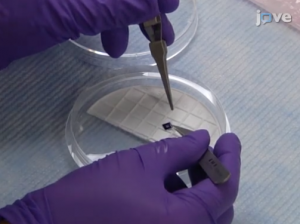Summary
Researchers at Baylor College of Medicine turned to JoVE video articles to learn three Drosophila protocols, reducing the required learning time from weeks to days, and saving thousands of dollars in lab costs and man-hours.
Challenge
Dr. Nikolaos Giagtzoglou was a postdoctoral researcher at Baylor College of Medicine, in the lab of Dr. Hugo Bellen. While studying endosomal pathways in cell signaling and neurodegeneration, he needed to learn three Drosophila-related techniques:
- The dissection and recording of the giant fiber system

- Ovary dissection
- Backfilling motor neurons with calcium indicators
These protocols dated back to the 1980s and have been relevant ever since — however, Dr. Giagtzoglou didn’t know anyone still actively using these methods, and who could teach them to him. “I really had no starting point to learn these techniques,” he explains.
Solution
Members of the Bellen lab turned to JoVE’s article library and streamed the relevant Drosophila protocol articles. “Watching a JoVE video article is so much more helpful than reading materials or methods sections, which can have grammatical mistakes, bad syntax, or may just generally be difficult to interpret,” says Dr. Giagtzoglou.
Also, JoVE video articles are streamed via the web and can be watched from anywhere, at any time. This offers another convenience: “Even when you meet someone who specializes in a technique, it can be hard to coordinate busy schedules to travel and learn the method,” as Dr. Giagtzoglou notes.

Results
In all, the Bellen lab staff streamed nine different JoVE Drosophila articles, both to learn new techniques and to review previously adopted ones. For instance, one article featured Dr. Gregory Macleod (then at the University of Texas at San Antonio), demonstrating the protocol for loading calcium indicators into Drosophila nerve terminals.
Overall, JoVE enabled:
- Dr. Giagtzoglu and his colleagues to learn a Drosophila technique in days, instead of in weeks (by relying on traditional methods)
- The reduction of the number of fly generations needed for experimental results — saving thousands of dollars in researcher hours and in fly maintenance costs
Additionally, Dr. Giagtzoglu participated in the publication of JoVE articles, including “Genetic Screens To Identify New Notch Pathway Mutants In Drosophila,” among others.



